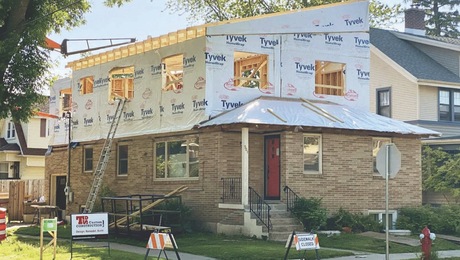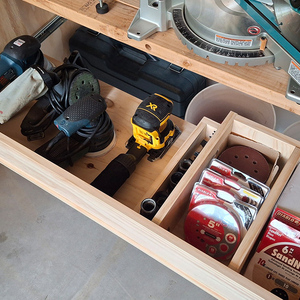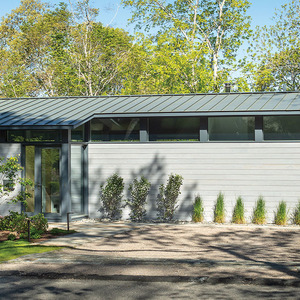*
I know there is a code requirement for ventilating these new tight houses being built. Can anybody tell me what is the minimum requirement? Then more importantly, what should be the actual specification? I don’t want a howling gale blowing through my home, but on the other hand, it is a fairly tight structure and I would hate to have to use bottled air to live in it.
Discussion Forum
Discussion Forum
Up Next
Video Shorts
Featured Story

Get expert guidance on finding a fixer-upper that's worth the effort.
Featured Video
How to Install Cable Rail Around Wood-Post CornersHighlights
"I have learned so much thanks to the searchable articles on the FHB website. I can confidently say that I expect to be a life-long subscriber." - M.K.
Fine Homebuilding Magazine
- Home Group
- Antique Trader
- Arts & Crafts Homes
- Bank Note Reporter
- Cabin Life
- Cuisine at Home
- Fine Gardening
- Fine Woodworking
- Green Building Advisor
- Garden Gate
- Horticulture
- Keep Craft Alive
- Log Home Living
- Military Trader/Vehicles
- Numismatic News
- Numismaster
- Old Cars Weekly
- Old House Journal
- Period Homes
- Popular Woodworking
- Script
- ShopNotes
- Sports Collectors Digest
- Threads
- Timber Home Living
- Traditional Building
- Woodsmith
- World Coin News
- Writer's Digest


















Replies
*
Gordon,
I believe makeup air is recommended at .35 (natural) ACH or less. Maybe an HVAC contractor could confirm this. We are also in the "tightening" business and highly recommend fresh air exchange for every project we do. You can't exhaust bathroom air, kitchen air, and laundry air without some new air to replace it. Without the proper ventilation system, you could be pulling your makeup air down the chimney. Not exactly my idea of a healthy house!
Sue
*While looking in other places for this information I found a group called the Idaho Energy commission. So I called them up and asked them about a standard. Apparently ASHRAE (I thinks that is the acronym) has a standard of .35 air changes per hour which matches Sue's suggestion. I intend to use a central system to ventilate the 3 bathrooms which based on that standard is 140 cfm. The gentlemen that I talked to reminded me of the need for make-up air for any vented combustion devices to prevent the backdraft problem. Anyway thanks for the input.gordon s.
*Gordon:As you can tell from these posts the home air flow subject is full of pseudo-science and snake oil as well as good sense and recommendations.The best recommendation is to contact the folks in your local area. Find out what has worked and what hasn't. Check with the building officials. Many cities now have Energy Efficiency Codes that you may have to comply with. Even if you don't they are a good place to start with your decisions. Don't forget the Cooperative Extension Office of your state university. Many now have specialists in energy efficient and healthy construction.Armed with this you can make a good decision on how to spend your energy dollar and maybe save your health in the process.
*Dear Fred,I do get it, but you missed my point. Local codes require that I do ventilate. Failure to do so, means I don't get a occupancy permit. No occupancy permit means I got one helluva an expensive 3 bathroom horse barn. What I was after was a design number that I could use to satisfy this requirement. I was also interested in what other individuals have done to meet similar requirements.The house is a two story structure with a walk-out basement. The main floor is about 1000 sq.ft. 1000 sq ft times 8 foot ceilings times 3 floors gives you a volume of 24,000 cubic feet. 24,000 times .35 air changes per hour equals 8400 cubic feet per hour. 8400 divided by 60 minutes per hour equals 140 cfm.140 cfm for 24 hours is in excess of 200,000 cubic feet of air. From my Machinerys handbook I found that a cubic foot of air weighs .0807 lbs at room temperature. It also has a specific heat at a constant pressure of .238 BTU/lb-F. So 200,000 cubic feet of air is 16,140 lbs of air. 16,140 lbs of air heated at a constant pressure (i.e., not in a sealed container) over a 40 degree F change would require 153,652 BTUs. At 3412 BTUs per kw-hr, 45 kw-hrs of electricity would be required. At $.07 per kw-hour that's $3.15 per day to temper that air. Not outrageous but certainly significant. As for the humidity,Boise is in a desert. The humidity is usually less than 20% most of the time except in the winter when it is higher, but after heating it is back to 20%. No humidifiers, you get used to it.You were right Fred, that was fun and you do have a point about the cost of this ventilation. Perhaps I should investigate heat recovery devices. At $1.50 a day (50% recovery) it wouldn't take too long to pay for one. Perhaps the simplest thing to do is to not run the thing all the time, and/or after the inspection is completed, turn it off or use it very sparingly like when one is in the bathroom to keep from getting asphyxiated.near the fan,gordon s.
*Got a buck a bottle, this elixer will cure all your ills.Seems to me that a bathroom fan, which will move an adequate volume of air, is just not located properly for whole-house ventilation. For one thing, it would be foolish to leave the fan on 24 hours, no mattter where its located. Timed, on-off cycles to get target levels of ACH would make more sense. But I wouldn't rely on a bathroom fan to ventilate my kitchen, bedroom and other living spaces. It depends what one is ventilating and why. I have been convinced by the guys on this site that an ERV/HRV is not cost effective for its "energy recovery" purpose. But if you add in the control of air changes/fresh air venting (if anyone has a building that's well enough sealed that they can control ACH this way) then the cost/benefit formula changes. A well sealed and insulated home in the northern (winter heating -- summer cooling) climates, will be making significant savings in overall energy consumption just by sealing and insulating. These houses need fresh air/elimination of bad air (particulates from cooking; other combustion appliances; bad odours; CO2; etc). Ventilation will have to exhaust and supply air to more rooms than the bathroom. The volumes will be low and the controlled exchange rate will be variable and infrequent. If combined ventilation and energy recovery costs $1.00 (give or take) a day, it should be calculated relative to the total energy bill. Heating, fresh air intake and bad air elimination of a combined seasonably revesible ERV/ventilation which also humidifies and dehumidifies, ducted throughout the house will net out as a significant savings. Compare it to a poorly sealed and insulated house or compare it to independent central heating, independent AC, independent dehumidifyers and humidifyers, and independent ventilation.
*
I know there is a code requirement for ventilating these new tight houses being built. Can anybody tell me what is the minimum requirement? Then more importantly, what should be the actual specification? I don't want a howling gale blowing through my home, but on the other hand, it is a fairly tight structure and I would hate to have to use bottled air to live in it.